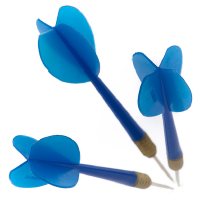This problem solving activity has a number focus.

What scores can Maddie get?
Maddie decides to change the rules. She can now add and subtract the 3s and 7s.
What possible positive scores can she get?
What whole positive numbers can Maddie get if she uses any of the four operations of addition, subtraction, multiplication and division?
- Apply the number operations to single digit numbers.
- Use a problem solving strategy to identify all the possible outcomes.
This problem gives students the opportunity to be systematic in the way they combine numbers, and to be alert to number patterns.
Note that this is not a probability problem. The challenge is to see what scores can be made.
- Copymaster of the problem (English)
- Copymaster of the problem (Māori)
- A dartboard or a picture of a dart board to introduce the problem
The Problem
Maddie has a dart board on which the outer ring scores 3 points and the inner ring scores 7 points. Maddie has three darts.
- What scores can Maddie get?
- Maddie decides to change the rules. She can now add and subtract the 3s and 7s. What possible positive scores can she get?
- What whole positive numbers can Maddie get if she uses any of the four operations of addition, subtraction, multiplication and division?
Teaching Sequence
- Introduce the problem with a discussion about the game of darts. Using the picture ask the students to share their understanding of the game.
- Display or draw the game board that is used in the problem.
- Ask the students to identify the highest score that can be obtained from throwing three darts.
- In pairs, ask the students to find all the possible scores obtained from throwing three darts. Encourage them to be systematic in recording what they find out.
- Share the possible scores.
- Pose parts (b) and then (c) of the problem for the students to work on. Check that they understand what is required.
- As they work, ask questions that focus students on their manipulation of numbers using the number operations. Encourage them to justify their solutions.
How did you begin part (b)?
Why did you start there?
How did you work out the scores?(Elaboration of mental strategies)
Do you think that you have found all the possible scores? How do you know? - As the students work, encourage them to record their solutions so that they can be shared with others in the class.
- Share solutions.
Extension
Students could be given more darts; there might be different points for the two rings of the board; more rings could be used.
They might also be asked how many ways there are of getting each number, or of getting negative whole numbers.
Solution
Maddie can get three 3s; two 3s and a 7; one 3 and two 7s; or three 7s.
- Maddie can only get 9, 13, 17 or 21.
- Maddie can now get 1 = 7 – 3 – 3; 3 = 3 + 3 – 3; 7 = 7 + 3 – 3; 11 = 7 + 7 – 3; in addition to the scores in (a). (It’s interesting to note here that it is not possible to get an even number using three odd numbers. Is it clear why?)
- And finally, Maddie can, as well as the addition and subtraction combination, get:
| 2 = 3x3 – 7 | 2 = (7 + 7) ÷ 7 | 2 = (3 + 3) ÷ 3 | 3 = 3 + 7 - 7 | 3 = 3 x 3 ÷ 3 |
| 3 = 3 x 7 ÷ 7 | 3 = 7 x 3 ÷ 7 | 3 = 3 ÷ 3 x 3 | 3 = 7 x 3 | 4 = 3 + 3/3 |
| 4 = 3 + 3/3 | 4 = 3 ÷3 + 3 | 4 = 3 + 7 ÷ 7 | 4 = 7 ÷7 + 3 | 6 = 3x3 – 3 |
| 7 = 3 ÷ 3 + 7 | 7 =7 x 7 ÷ 7 | 7 = 7 x 3 ÷ 3 | 7 = 3 x 7 ÷ 3 | 7 = 3 ÷3 x 7 |
| 7 = 7 ÷7 x 7 | 8 = 7 + 7/7 | 8 = 7 ÷ 7 + 7 | 10 = 7 + (3 ÷ 3) | 12 = 3 x 3 + 3 |
| 12 = (7 - 3) x 3 | 14 = 3 x7 – 7; | 16 = 3 x3 + 7; | 18 = 3x 7– 3 | 18 = (3 + 3) x 3 |
| 24 = 3 x 7+ 3 | 27 = 3 x 3 x 3 | 28 = (7 – 3)x7 | 28 = 3 x 7 + 7 | 30 = (7 + 3)x3 |
| 42 = (7 + 7)x3 | 42 = 7 x 7 + 7 | 42 = (3 + 3) x 7 | 46 = 7x7– 3 | 46 = 7x7– 3 |
| 52 = 7 x 7 + 3 | 56 = 7 x 7+ 7 | 63 = 3 x 3 x 7 | 70 = (7 + 3) x7 | 98 = (7 + 7)x 7 |
| 147 = 3 x7x7 | 343 = 7 x 7 x7 |
Note the systematic approach to finding these solutions.